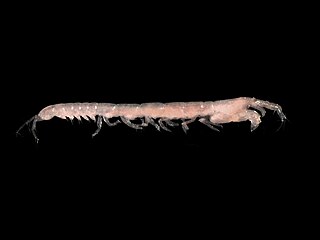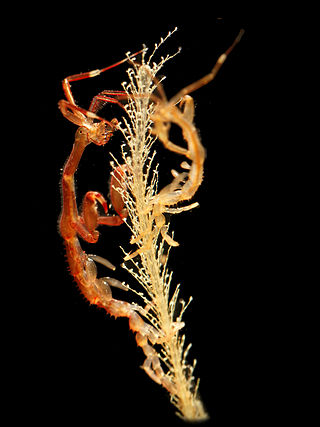
Amphipoda is an order of malacostracan crustaceans with no carapace and generally with laterally compressed bodies. Amphipods range in size from 1 to 340 millimetres and are mostly detritivores or scavengers. There are more than 9,900 amphipod species so far described. They are mostly marine animals, but are found in almost all aquatic environments. Some 1,900 species live in fresh water, and the order also includes the terrestrial sandhoppers such as Talitrus saltator and Arcitalitrus sylvaticus.

Remipedia is a class of blind crustaceans, closely related to hexapods, found in coastal aquifers which contain saline groundwater, with populations identified in almost every ocean basin so far explored, including in Australia, the Caribbean Sea, and the Atlantic Ocean. The first described remipede was the fossil Tesnusocaris goldichi. Since 1979, at least seventeen living species have been identified in subtropical regions around the world.

The Stenopodidea or boxer shrimps are a small group of decapod crustaceans. Often confused with Caridea shrimp or Dendrobranchiata prawns, they are neither, belonging to their own group.

The crustacean order Tanaidacea make up a minor group within the class Malacostraca. There are about 940 species in this order.

Ingolfiellidea is a small suborder of amphipods with only two families, Ingolfiellidae and Metaingolfiellidae. They are small, vermiform (worm-like) animals that live "in the soft mud of the deep-sea floor, as well as in high mountain freshwater river beds, or in subterranean fresh, brackish and marine interstitial waters of continental ground waters and continental shelves". Over 30 species are known from two families.

Talitridae is a family of amphipods. Terrestrial species are often referred to as landhoppers and beach dwellers are called sandhoppers or sand fleas. The name sand flea is misleading, though, because these talitrid amphipods are not siphonapterans, do not bite people, and are not limited to sandy beaches.

Lysianassidae is a family of marine amphipods, containing the following genera:

Gammaridae is a family of amphipods. In North America they are included among the folk taxonomic category of "scuds", and otherwise gammarids is usually used as a common name.
Talorchestia is a genus of amphipod of the family Talitridae, containing the following species:

Bogidiella is a genus of crustacean in the family Bogidiellidae, containing the following species:
Ingolfiella longipes is a species of amphipod crustacean in the family Ingolfiellidae notable for its orange striped coloration. It is known from a single specimen held at the Naturalis Biodiversity Center. It was collected from Walsingham Sink Cave, an anchialine cave in Hamilton Parish, Bermuda, and is thus considered to be critically endangered.

Ingolfiella is a genus of amphipod in the family Ingolfiellidae, containing the following species:

Cyclida is an extinct order of crab-like fossil arthropods that lived from the Carboniferous to the Jurassic and possibly Cretaceous. Their classification is uncertain, but they are generally interpreted as crustaceans, likely belonging to the superclass Multicrustacea.

Spongicolidae is a family of glass sponge shrimps in the order Decapoda. There are about 8 genera and more than 40 described species in Spongicolidae.

Caprella is a large genus of skeleton shrimps belonging to the subfamily Caprellinae of the family Caprellidae. It includes approximately 170 species. The genus was first established by Jean-Baptiste Lamarck in his great work Système des animaux sans vertèbres (1801) to describe Cancer linearis and Squilla ventricosa.

Bogidiellidae is a family of amphipod crustaceans, containing the following genera:

The clade Multicrustacea constitutes the largest superclass of crustaceans, containing approximately four-fifths of all described crustacean species, including crabs, lobsters, crayfish, shrimp, krill, prawns, woodlice, barnacles, copepods, amphipods, mantis shrimp and others. The largest branch of multicrustacea is the class Malacostraca.

Maera is a genus of amphipod crustacean in the family Maeridae, and was first described by William Elford Leach in 1814. The type taxon is Cancer (Gammarus) grossimanus Montagu, 1808, currently accepted as Maera grossimana.

Maeridae is a family of marine amphipods, which was first described by Taudl Krapp-Schickel in 2008.














